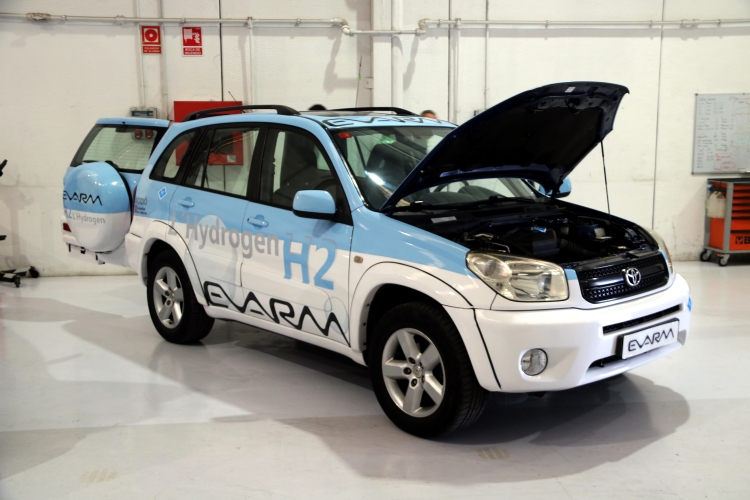Catalan company creates first vehicle running with green hydrogen in Spain
EVARM is known for converting polluting vehicles to ones using alternative fuels

The first truck running with green hydrogen could be driving around the streets of Catalonia by 2023. The engineering company, EVARM, based in the city of Sant Boi de Llobregat, near Barcelona, on Wednesday launched the first vehicle in Spain running with this alternative fuel.
They plan to start transforming trucks using the technology in 2023 after it has been through all the required technical tests. These vehicles will have a driving range of two working days.
"After four years of work, we have developed an efficient technology, 100% green, and available for companies to apply at an affordable cost," Xavier Ribas, EVARM CEO said.
The solution proposed by the Catalan company is "feasible" for all businesses as it will convert a polluting truck into a zero-emission vehicle, something not currently possible with electric cars.
"Through the R&D process and after building the prototype, we have shown that the technology is efficient and it is a solution for everybody," Ribas said.
For the project, in development since 2019, the team has received up to €200,000 in subsidies from Catalonia Trade & Investment.
EVARM expects to create 30 new workplaces after opening a 3,000 sq meter warehouse in Sant Boi de Llobregat.
What is green hydrogen?
Green hydrogen is one of the options for greener fuels of the future. However, the concept is relatively unknown as it is not fully exploited due to the current high cost.
"Hydrogen is the simplest and smallest element in the periodic table. No matter how it is produced, it ends up with the same carbon-free molecule. However, the pathways to produce it are very diverse, and so are the emissions of greenhouse gases like carbon dioxide (CO2) and methane (CH4)," Dr Emanuele Taibi, Head of the Power Sector Transformation Strategies, International Renewable Energy Agency (IRENA), told the World Economic Forum.
The process to create green hydrogen is defined as the "hydrogen produced by splitting water into hydrogen and oxygen using renewable electricity," Dr Taibi added.
In fact, green hydrogen could save up to "830 million tonnes of carbon dioxide per year, emitted when producing hydrogen using fossil fuels. The amount of carbon dioxide "is equivalent to the CO2 emissions of the United Kingdom and Indonesia combined," the International Energy Agency reported.
Green hydrogen in Catalonia
The Catalan president, Pere Aragonès, visited Germany in mid-March, where the governments of Catalonia and Baden-Württemberg agreed to create a working group to develop green hydrogen projects.
Aragonès made the announcement in Stuttgart following a meeting with Winfried Kretschmann, Minister-President of Baden-Württemberg, which was also attended by Catalan business minister Roger Torrent.
During the trip, the Catalan president also announced a €10 million investment from German company Freudenberg to open an automotive components factory in Catalonia.
Nissan factory's possible successor
Nissan’s successor in the plants it occupied in Catalonia is still unknown, after the Japanese firm pulled out. Months of talks between firms and several other parties including unions representing redundant workers has not resulted in a final outcome.
Nissan left its factory in Barcelona’s Zona Franca at the end of 2021, yet the future of the plant is still not clear. The main candidate is a decarbonization hub (d-hub) led by QEV Technologies and BTech, as well as Silence, a leading electric motorbikes brand.
On Wednesday, these companies launched their goal to manufacture 100,000 vehicles of two different brands over five years.
"We expect to start hiring people for the reindustrialization process in June, and slowly hire 100 or 200 people this year to start preparing the manufacturing line," Joan Orús, QEV Technologies CEO, said to media outlets.
The new vehicles brand, ZEROID, will account for up to 60,000 electrical trucks and vans, while the other 40,000 ones will be under the historic Ebro brand, recovered in a joint venture between QEV Technologies and BTech.
The Ebro was the vehicle brand created during the Spanish Francoist dictatorship for the Motor Ibérica company. They used to manufacture trucks, tractors, and construction machinery.
Motor Ibérica used to build vehicles in what is now the former-Nissan factory. The Japanese company had acquired 80% of the Spanish brand by 1986, and the Ebro brand disappeared from vehicles.